Are you a big plotter? Some writers like the freedom of creating on the spot, while others can’t imagine approaching their manuscript without even a rough plot structure to guide them through the meanders of their imagination.
Today, we’re learning all about popular story structures many of your favorite books and television shows are based upon. We’re venturing to explore everything from traditional three-act structures to slightly more advanced plot frameworks.
What Is Story Structure?
Story structure refers to the arrangement of elements within a narrative. It’s like a blueprint that guides the reader through the story, ensuring a satisfying experience.
Many writers use those blueprints in the planning process to organize their ideas, pinpoint the most impactful moments, and improve the pacing. However, even though it’s a perfectly adequate tool to use, you don’t need to religiously follow already existing plot structures in order to write a good story.
Remember
You’re the master of this sea! Don’t limit your creativity just to fit the mold. Write a story you want to see in the world and use plot structures when you need a bit of support. In doubt, be sure to talk through your ideas with your editor or someone close and devoted to your book!
In this comprehensive guide, we will take a look at some of the most commonly used plot structures in modern literature.
Ready to reach your full potential as the next New York Times bestselling author? Let’s begin.
1. The Three-Act Structure
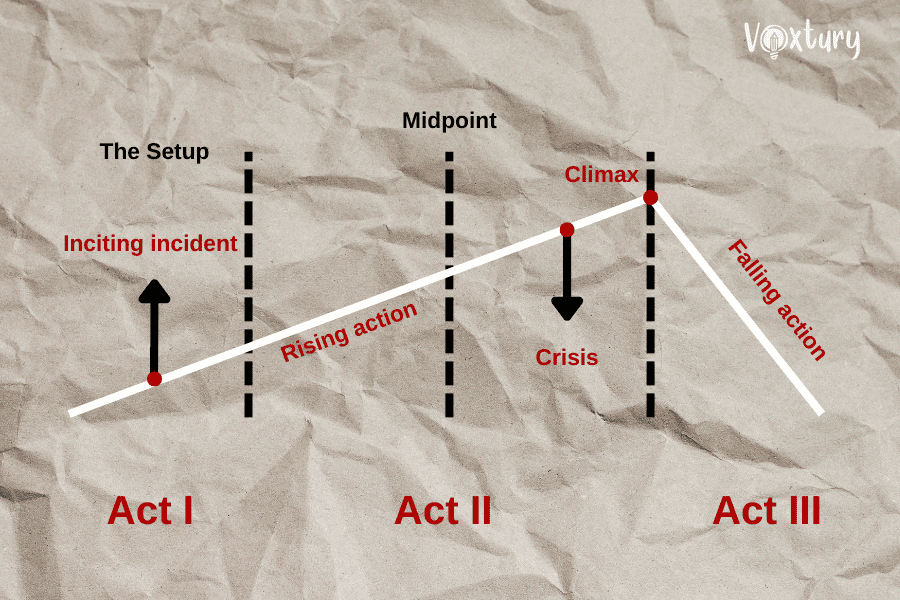
Let’s start with something basic you probably learned at school. The three-act structure splits your story into three main components: the setup, the confrontation, and the resolution.
It’s one of the most common and easy-to-understand plot structures that often serves as a base for many other blueprints we’ll talk about later. Here, we have:
Act I: The Setup
- Introduction of characters and setting
- Inciting incident
- The character makes a decision to tackle the challenge
Act II: The Confrontation
- Rising action: The protagonist faces a series of obstacles and challenges as they strive to achieve their goal.
- Midpoint: A turning point in the story, often introducing a new complication or revealing a significant truth.
- Crisis: The protagonist faces their greatest challenge or conflict, leading to a climactic moment.
Act III: The Resolution
- Climax: The highest point of tension and excitement in the story
- Falling action: The events following the climax
- Denouement: The conclusion of the story, where loose ends are tied up, and the story comes to a satisfying end.
Please, note
Climax doesn’t have to involve a physical altercation with an antagonist. While in many stories, the plot is driven by physical conflict (like a battle or a fight), this will not be the case for every book. The climax is meant to resolve the conflict our protagonist struggled with throughout the story, be it choosing the right career path or reclaiming their independence, among many other possible conflicts.
2. Freytag’s Pyramid
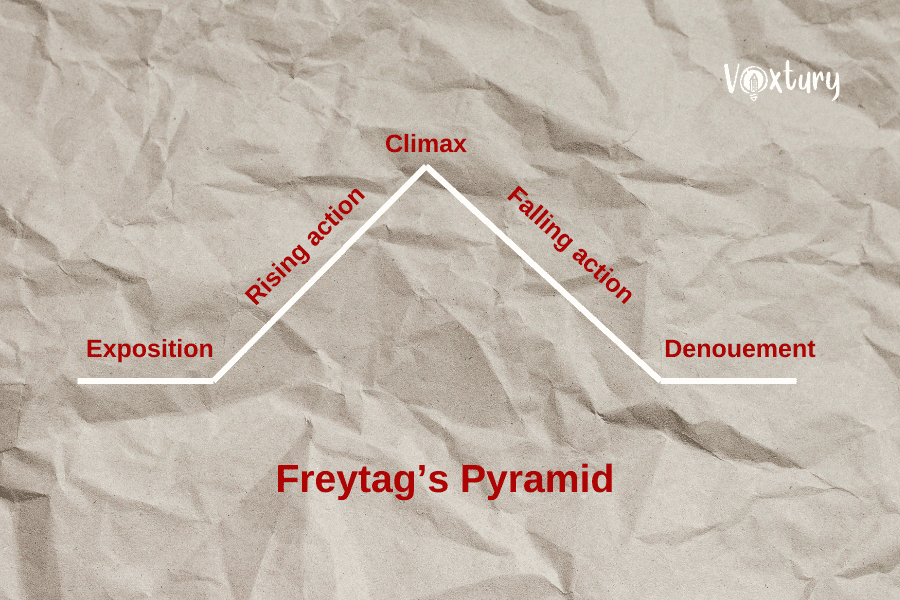
Freytag’s Pyramid is a visual representation of the classic five-act structure, developed by Gustav Freytag in the 19th century. He took inspiration from classical Greek tragedies to build an easy-to-follow five-act story structure that repeats many of the beats present in the three-act structure.
The five components of Freytag’s Pyramid are:
- Exposition: Characters, setting, and background information are introduced.
- Rising Action: This is the buildup of tension and conflict as the story progresses.
- Climax: The highest point of tension in the story, where the protagonist faces their greatest challenge.
- Falling Action: The aftermath of the climax, as the tension and conflict begin to resolve.
- Denouement: The conclusion of the story.
Good to know
Freytag’s Pyramid is a widely used structure in Western literature, especially in novels and plays. However, while Freytag’s Pyramid is a helpful tool, it’s not a rigid rule. Many stories deviate from this structure, especially in modern literature, where authors often experiment with different narrative techniques.
3. The Hero’s Journey
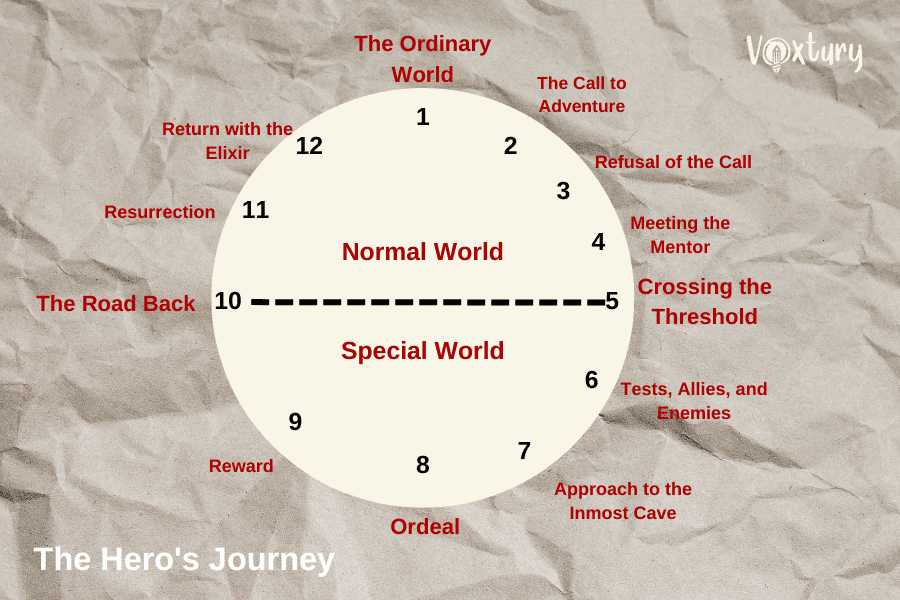
Some consider The Hero’s Journey the most popular story structure in today’s media, including books. Famously, George Lucas took a lot of inspiration from this blueprint when creating Star Wars, which explains its strong and persisting influence on many storytellers and enjoyers alike.
The Hero’s Journey is a cyclical structure based on Joseph Campbell’s monomyth, which describes the common patterns found in myths and stories across various cultures.
The Hero’s Journey can be broken down into these stages:
- The Ordinary World: The hero is introduced in their everyday life.
- The Call to Adventure: The hero receives a challenge or quest that will disrupt their ordinary life.
- Refusal of the Call: The hero may initially hesitate or resist the call.
- Meeting the Mentor: The hero meets a wise mentor who provides guidance and training.
- Crossing the Threshold: The protagonist leaves their ordinary world and enters the unknown.
- Tests, Allies, and Enemies: They face challenges, meet allies, and encounter enemies.
- Approach to the Inmost Cave: The hero reaches the central challenge or crisis point of the journey.
- Ordeal: The hero undergoes a severe test or trial.
- Reward: The hero achieves their goal or overcomes the ordeal.
- The Road Back: The hero begins the journey back to their ordinary world.
- Resurrection: The hero faces a final challenge or temptation on their way back to test everything they’ve learned up until this point.
- Return with the Elixir: The hero returns to their ordinary world with a newfound understanding or power.
Good to note
The Hero’s Journey provides a deep understanding of the underlying archetypes and patterns found in heroic narratives. However, it’s still a flexible framework that can be adapted to fit various stories.
4. Fichtean Curve
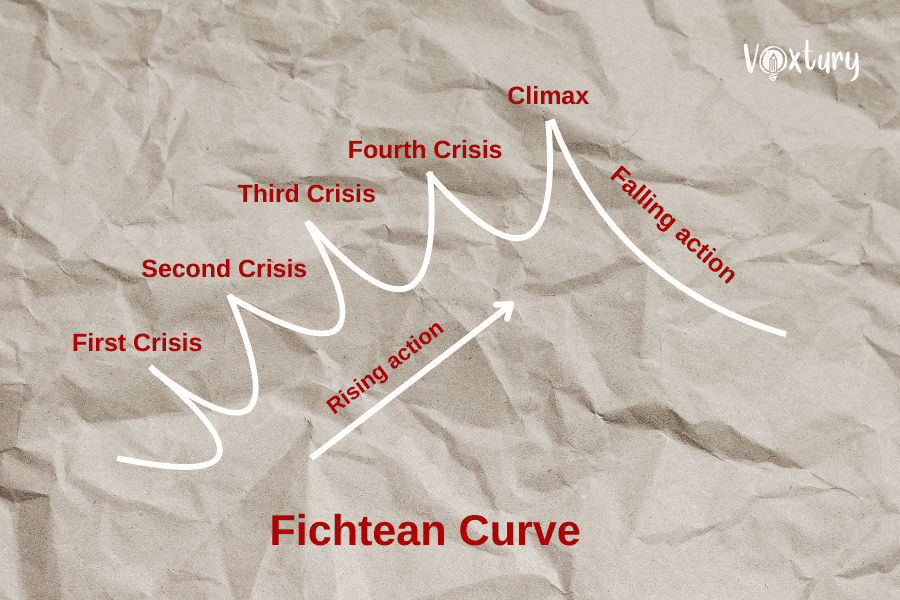
We’ve talked about pyramids, so now it’s time to cover curves. The Fichtean Curve is a psychological model that describes the cyclical nature of human motivation and achievement. It was developed by German philosopher Johann Gottlieb Fichte.
This novel structure is a bit similar to Freytag’s Pyramid in a way that it encourages authors to incorporate dynamic pacing, with many mini-crises that push the story forward.
This model can be broken down into the following stages:
- Rising Action
- Immediate introduction of conflict: For example, the story begins with a shocking statement that immediately hooks the reader.
- First Crisis
- Major plot development: We get introduced to the first big revelation/conflict of the book.
- Second Crisis
- We introduce another crisis that directly relates to the previous one, increasing the stakes or explaining the characters’ predicament further.
- Third Crisis
- The formula remains the same as above; only the following conflicts should gradually increase the stakes.
- Fourth Crisis
- We uncover the hidden truth or face the impending crisis that ties all the previous ones together.
- Climax
- Emotional impact: The climax is both devastating and cathartic, providing a powerful resolution to the story.
- Falling Action
- Resolving loose ends: The ending offers closure, but it can also leave some questions unanswered, giving the reader the opportunity to draw their own conclusions.
All in all, this story structure relies on the three-act structure with Rising Action, Climax, and Falling Action as the main components.
Remember
Fichtean Curve is great for writers who like to start their manuscripts with immediate impact. We’re not spending a lot of time introducing characters and their world. In fact, this model encourages jumping straight to the first important conflict of the book, embracing dynamic pacing in the series of escalating conflicts and triumphs.
5. Save the Cat Beat Sheet
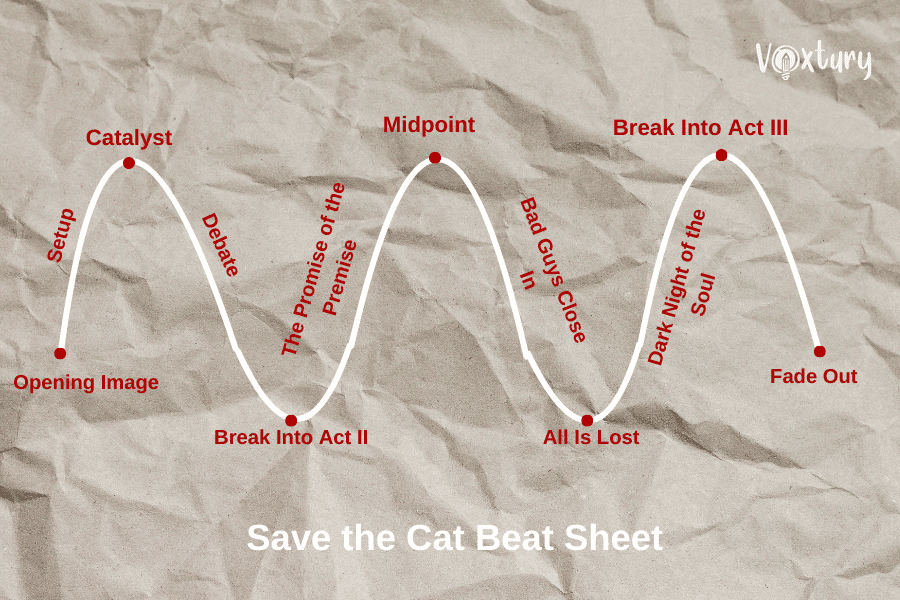
Save the Cat Beat Sheet originated in screenplay writing. Developed by Hollywood screenwriter Blake Snyder, it outlines a simplified story structure, breaking it down into 15 beats that correspond to key plot points.
While primarily used for screenwriting, the principles can be adapted to other forms of storytelling.
Here’s a breakdown of the 15 beats in the Save the Cat Beat Sheet:
- Opening Image: This is the first shot of the film/book, setting the tone and introducing the main character.
- Setup: The opening paragraphs which introduce the main character, their world, and the status quo.
- Theme Stated: A line of dialogue or a visual cue clearly states the theme of the story, the truth that your protagonist will need to uncover by its end.
- Catalyst: The inciting incident, an event that disrupts the main character’s life and sets the story in motion.
- Debate: The main character struggles with the decision to accept the challenge or quest.
- Break into Act Two: A turning point where the main character commits to the journey.
- B-Story: A secondary plot that runs parallel to the main story starts. For example, this is when a romantic subplot would be introduced.
- The Promise of the Premise: Often referred to as the ‘fun and games’ stage, this is typically a highly enjoyable section where the writer delivers on their promises. We see characters engaging in genre-typical activities.
- Midpoint: A turning point in the story, often introducing a new complication or revealing a significant truth.
- Bad Guys Close In: The antagonists become more threatening and intensify the conflict.
- All Is Lost: The main character faces their darkest moment and appears to be defeated.
- Dark Night of the Soul: The main character experiences a moment of introspection and self-doubt.
- Break into Act Three: A turning point where the main character finds renewed hope or determination.
- Final Battle: The climactic confrontation between the protagonist and antagonist. The main conflict is resolved, and the story comes to a satisfying conclusion.
- Fade Out: The final shot/scene of the book, often echoing the opening image/themes and providing a sense of closure.
Interesting to note
In the original Save the Cat Beat Sheet, we see the exact page numbers on which each beat should take place (for a 110-page screenplay). While it’s helpful for screenwriters, this doesn’t work so well when translated into the world of prose. You can take inspiration from such division but don’t stress too much about fitting your beats in those exact brackets when writing your book.
6. Dan Harmon’s Story Circle
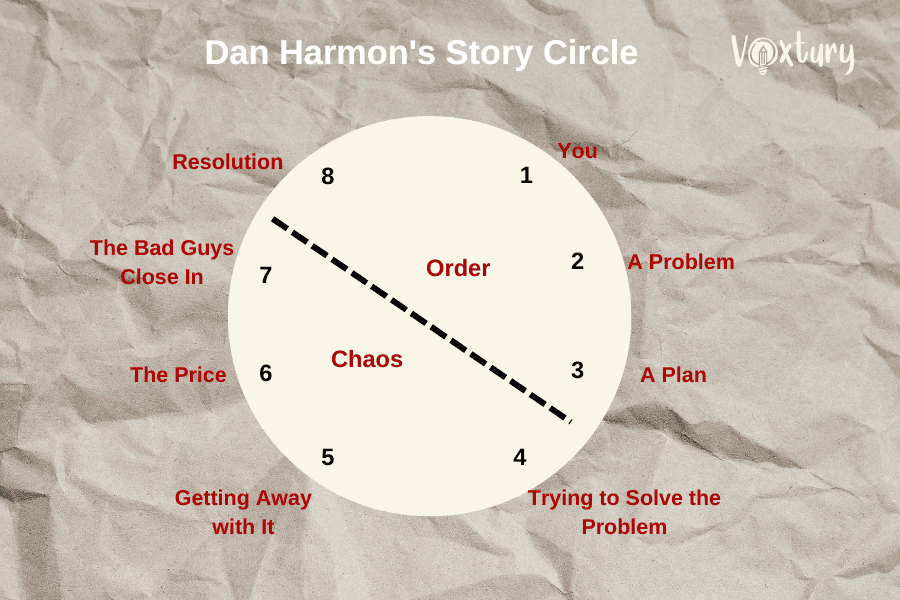
If you know and love Rick and Morty, you might be pleasantly surprised by the fact that our next novel structure was brought to you by its co-creator, Dan Harmon.
Story Circle is a cyclical narrative structure that breaks down a story into eight stages. It’s inspired by Joseph Campbell’s Hero’s Journey and finds its foundations in the three-act story arc.
Here are the eight stages of Dan Harmon’s Story Circle:
- You: The story begins with the protagonist in their ordinary world.
- A Problem: An event or situation disrupts the protagonist’s life and introduces a problem.
- A Plan: The protagonist develops a plan to solve the problem.
- Trying to Solve the Problem: The protagonist attempts to execute their plan.
- Getting Away with It: The protagonist seems to be succeeding, but the problem is not entirely solved.
- The Price: The protagonist realizes the negative consequences of their actions, or the problem is revealed in a new light.
- The Bad Guys Close In: The protagonist is confronted with the full extent of the problem and its consequences.
- Resolution: The protagonist overcomes the problem and learns a valuable lesson.
A structure like this works particularly well in a 30-minute sitcom format, where each episode takes the heroes on a different journey; however, they are not forced to undergo serious character growth. Still, within this story structure, characters have a chance to learn some smaller truths about themselves, leading up to more groundbreaking changes near the season’s end.
For a book format, this structure works just as well, allowing you to dig deep and explore your protagonist’s struggles and character.
Remember
This structure, in particular, draws a lot from the classic Hero’s Journey, focusing on the character’s inner development and learning new truths about the world. To execute it well and add nuance to your story, you should spend some time getting to know your characters, their motivations, hidden demons, etc.
7. Seven-Point Story Structure
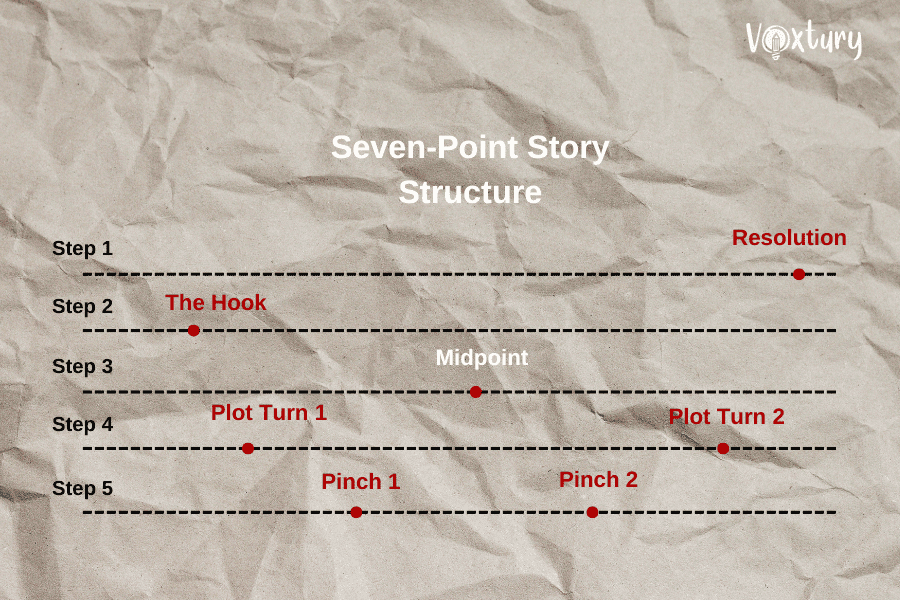
Seven-Point Story Structure is, once again, a fairly new proposition in the world of storytelling. Introduced in 2013 by sci-fi author Dan Wells, this blueprint builds upon the three-act structure, but offers an innovative way of utilizing it.
Here’s what Seven-Point Story Structure looks like broken down:
- The Hook: In the opening sequence, we meet the main character and their world.
- Plot Turn 1: This corresponds to the Catalyst in other plot structures. It’s the event that sets the story in motion.
- Pinch 1: At this point, we are introduced to the antagonist, who becomes a significant threat.
- Midpoint: A turning point where the protagonist’s perspective or approach shifts – usually, going from reaction to action.
- Pinch 2: The protagonist faces their greatest challenge and appears to be defeated.
- Plot Turn 2: The protagonist finds a new path or solution to resolve the major conflict in the story and defeat the antagonist.
- Resolution: The conflict is resolved, and the story concludes.
The Seven-Point Story novel structure is a mirror reflection when we’re looking from the midpoint perspective. That creates a perfect opportunity to craft a strong story with great symbolism by juxtaposing the start of the story with its ending.
A Useful Tip
Dan Wells encourages writers to work on their resolution first and, based on it, build an impactful hook. This way, you can achieve a stark contrast or effective parallels with how the story begins and ends, marking a grand evolution of the protagonist’s character and outlook on the world.
Conclusion
And here we are – hopefully, by the end of this guide, you know more about common plot structures and how you can use them to improve your plotting process.
As always, we invite you to check the Book Writing section of our website, where you will find many valuable resources to hone your writing skills, find tested tools, and expert advice on how to write and promote your book.